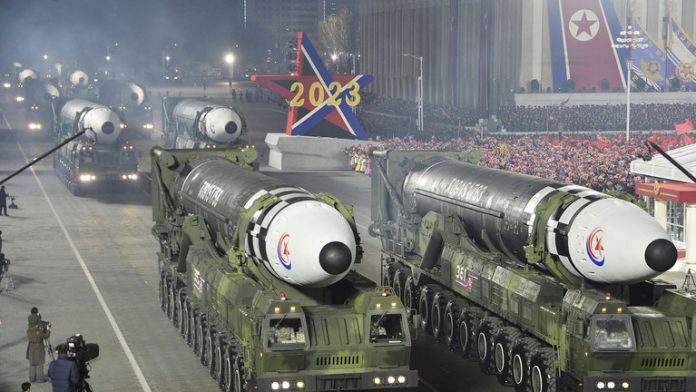|
Lazy eyes listen
|
NewsRescue
North Korea flexed its muscles once more on Wednesday, displaying the most intercontinental ballistic missiles it has ever paraded in its capital Pyongyang, according to experts. The military force display included eleven of its newest Hwasong-17 rockets.
According to the Korean Central News Agency (KCNA), the “grand” event was held to commemorate the DPRK military’s 75th anniversary.
Kim Jong-un, the country’s Supreme Leader, was present, as were his wife Ri Sol-ju and their daughter Kim Ju-ae.
Among the parade’s “ultra-modern military hardware” were “tactical nuclear weapons operation units,” according to KCNA.
These were followed by Hwasong-17 intercontinental ballistic missiles (ICBM), which the state-run media claims represent the DPRK’s “tremendous nuclear-strike capability.”
The message to any potential adversaries was “nuke for [a] nuke and all-out-confrontation for an all-out-confrontation,” according to the report.
In 2022, Pyongyang conducted the first known test of the Hwasong-17.
Ankit Panda of the US-based Carnegie Endowment for International Peace argued on Twitter on Thursday that “this is cumulatively more ICBM launchers than we’ve ever seen before at a North Korean parade.”
According to Politico media, based on the photos released by KCNA, North Korea appears to now have enough missiles to “conceivably overwhelm the United States’ defense against them.”
According to Politico, the US has 44 ground-based interceptors capable of destroying an incoming North Korean ICBM. However, if the DPRK’s missiles can carry four warheads, their number would outnumber American defenses, according to the report.
The parade this week was described as a “defiant display” that highlighted Pyongyang’s “stunning military advancement and Western failures to persuade the ruling Kim family to hand over its weapons.”
Some Western experts were also intrigued by what they believe to be a prototype or mockup of a new solid-fuel ICBM.
While the DPRK has so far relied on missiles that must be filled with liquid fuel at a launch site, the country has been working for some time to develop a solid-fuel alternative.
If North Korea succeeds, its military will have rockets that do not require a time-consuming fueling process before launch, making them more difficult to detect during a conflict.





